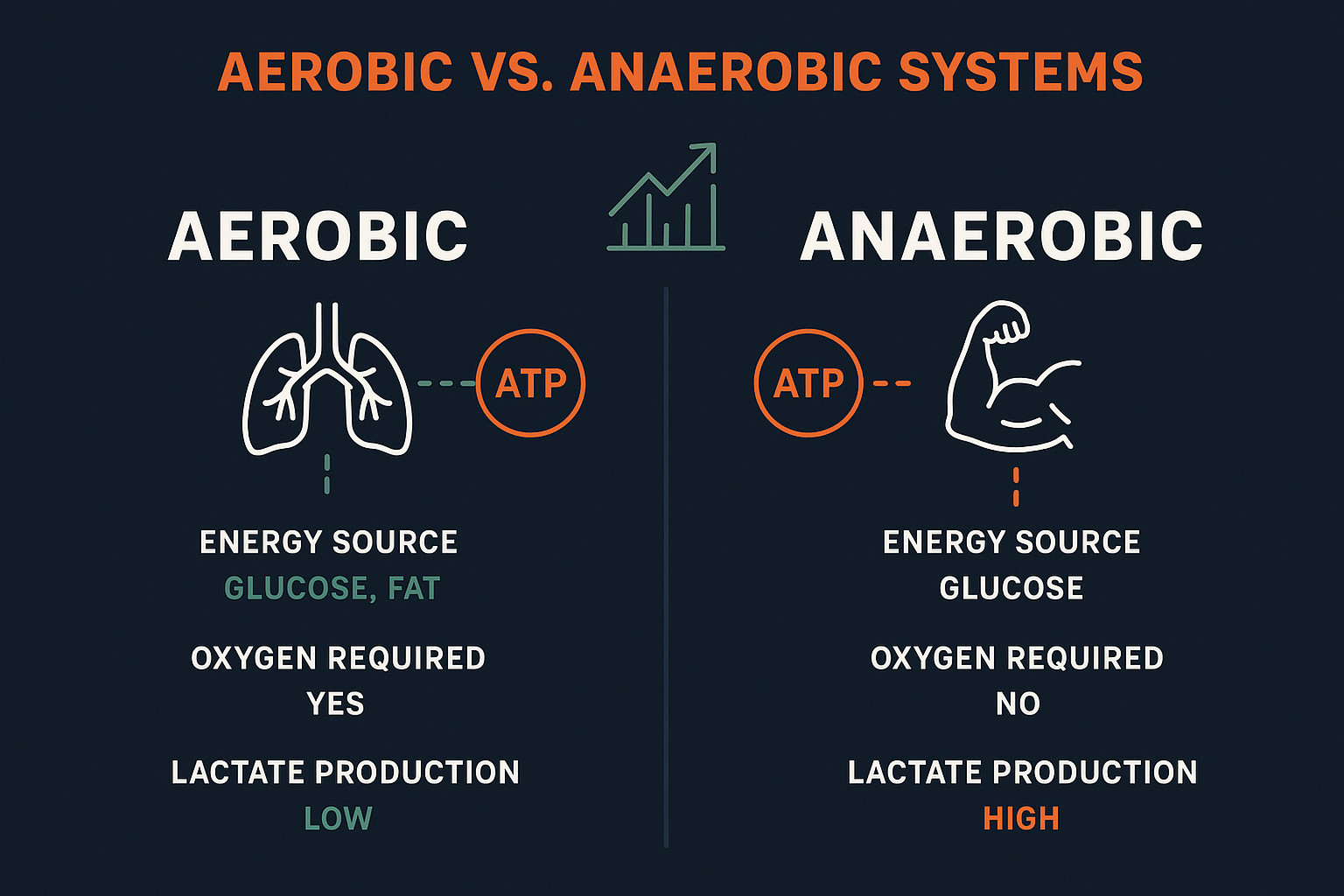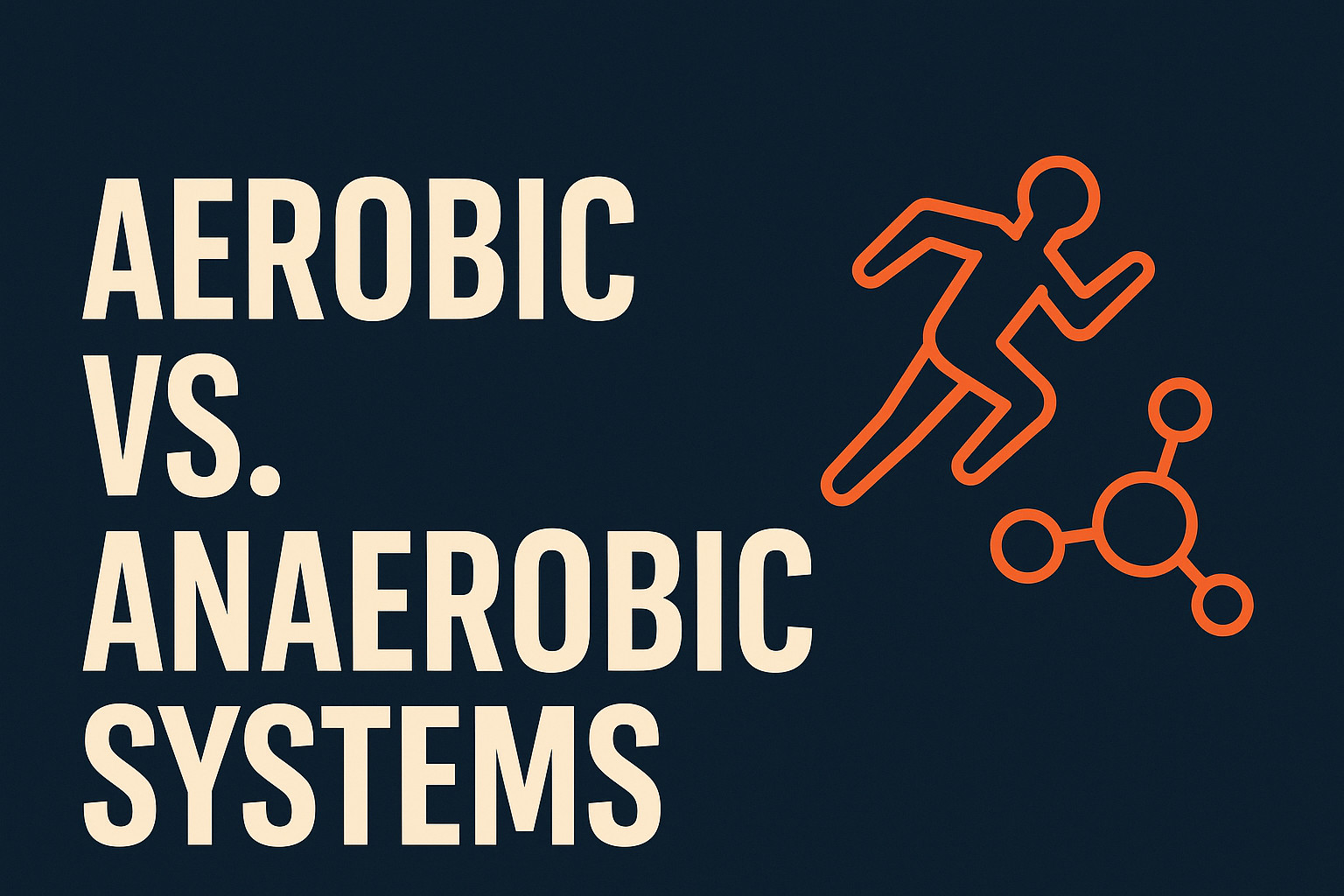Introduction
If you're a serious runner — whether you're chasing a marathon PR or mastering the 5K — it pays to understand what's happening under the hood. Every stride you take is powered by energy, and that energy comes from two core systems: the aerobic and anaerobic systems.
Knowing how these systems work, what fuels them, and how your training develops them will help you become a smarter, more effective athlete.
First, What Is ATP?
ATP (adenosine triphosphate) is the energy currency of your body.
Every muscle contraction — from the slowest jog to the hardest sprint — requires ATP. Your body has a very small reserve of it, so it must constantly regenerate ATP through different energy systems.
There are three energy systems, but for runners, the two that matter most are:
- Aerobic system (uses oxygen)
- Anaerobic system (does not use oxygen)
The Aerobic System
(Primary engine for endurance)
How it works:
The aerobic system uses oxygen to break down carbohydrates and fat into ATP. This process is slower but much more efficient — it can generate ATP for hours.
Key fuel sources:
- Glycogen (stored carbs)
- Fat (especially in long-duration, low-intensity efforts)
Oxygen requirement:
Yes — oxygen is essential. That's why your breathing rate increases when you run longer or harder.
Lactate production:
Minimal. Lactate is produced in small amounts and easily cleared by the body.
When it dominates:
- Long slow runs
- Easy and recovery runs
- Tempo runs (mostly aerobic, especially in longer formats)
- Marathon and ultra distances
The Anaerobic System
(Your backup for bursts and speed)
How it works:
The anaerobic system produces ATP without oxygen, relying primarily on glycolysis — the breakdown of glucose — for fast energy.
It's fast, but produces less ATP and creates lactate as a byproduct, which builds up when intensity is high.
Key fuel source:
Glucose (from muscle glycogen or blood sugar)
Oxygen requirement:
No — but this comes at a cost (lactate accumulation, fatigue).
Lactate production:
High. Lactate builds when you're working harder than your body can clear it.
When it dominates:
- Interval workouts
- Sprints and surges
- Hill repeats
- The final kick of a race
- Training near or above VO₂ max (e.g., hard 400m reps)
What Is Lactate and Why Does It Matter?
Lactate isn't a villain — it's a fuel. But when your body produces it faster than it can clear it, it begins to accumulate, causing burning legs, heavy breathing, and fatigue.
The key threshold:
Lactate Threshold (LT) is the tipping point — the fastest pace you can sustain without rapid lactate buildup.
Training near LT (like in tempo runs) improves your ability to clear lactate, letting you run faster for longer aerobically.

Understanding how aerobic and anaerobic systems work together
Training Impacts: How Each Workout Targets These Systems
🟦 Long Slow Runs
Target: Aerobic system
Effect: Increases mitochondrial density, fat utilization, oxygen delivery, and overall efficiency
Adaptations:
- Stronger heart
- More capillaries in muscles
- Enhanced ability to use fat as fuel
🟧 Tempo Runs
Target: Lactate threshold (aerobic with anaerobic crossover)
Effect: Teaches the body to process lactate more efficiently and sustain faster aerobic effort
Adaptations:
- Raised lactate threshold
- Improved muscular endurance
- More effective oxygen usage
🔴 Interval Training
Target: Anaerobic system and VO₂ max
Effect: Pushes your maximal aerobic capacity and trains high-intensity tolerance
Adaptations:
- Increased VO₂ max (how much oxygen you can use)
- Greater lactate tolerance
- Faster recovery between hard efforts
A Balanced System: Why You Need Both
Even the most endurance-heavy race has moments where the anaerobic system kicks in — a climb, a surge, or the sprint to the finish. Conversely, even sprinters need a solid aerobic base to recover quickly between bouts of speed.
Great runners train both systems. And they know when to push, when to pull back, and how to sequence their training for peak effect.
Key Insight
ATP is the fuel. Oxygen is the gatekeeper. Lactate is the signal. And your training is the switchboard that wires it all together.
Final Word
The aerobic system is your long-range engine.
The anaerobic system is your turbo boost.
Smart training makes them both stronger — and teaches your body how to blend them when needed.
Key Takeaway
Train with understanding.
Run with purpose.
Elite You.
